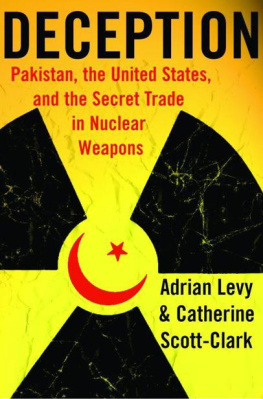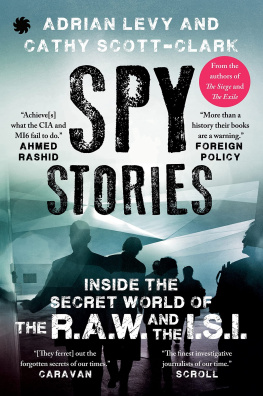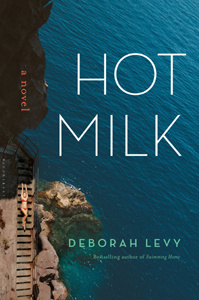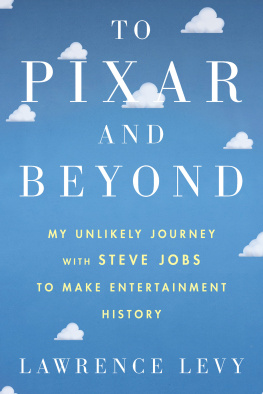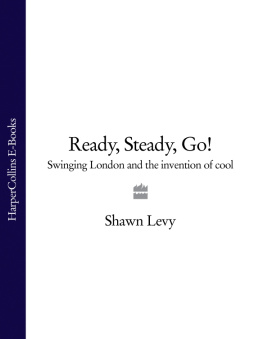
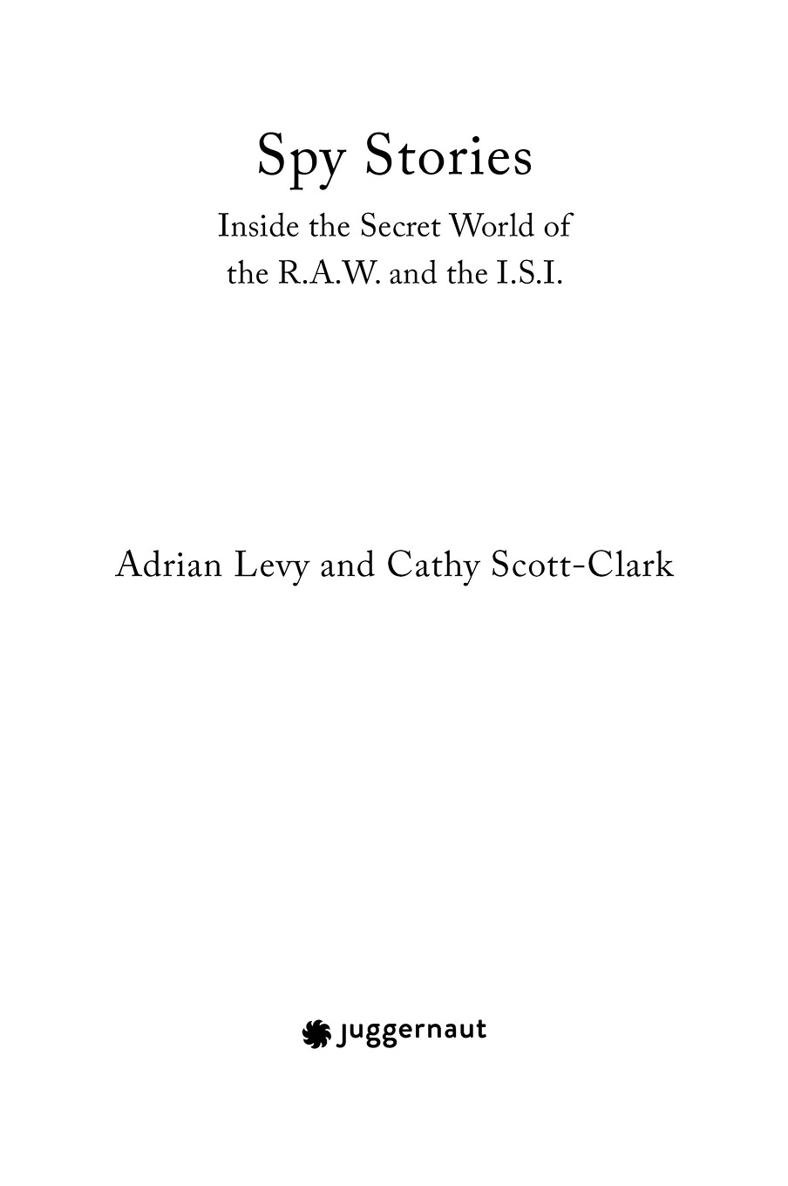
For Z&A
It is always better to admire the best among our foes rather
than the worst among our friends
Viet Thanh Nguyen, The Sympathizer
Acknowledgements and a Note onSources and Methods
What follows are personal accounts and, occasionally, the regretfulrecollections of rival officers and analysts working to outwit andtrap one another in the ground zero of the spy wars. The principals inthis book are from Indias Research and Analysis Wing (R.A.W.),which is rarely talked about at all, and has been denigrated as abureaucratic vipers nest, while its enemies, in Pakistans Inter-Services Intelligence (I.S.I.), are spoken about all the time, butmostly portrayed as mysterious, self-serving, and deadly.
These are politically tinged tropes, and in the pages that followspies from both secret services appear altogether different, as theydescribe how they became (and some still are) invisible protagonists,knee-deep in chaos, a few of them becoming militant, some losingtraction, others having religious and political epiphanies, some goingrogue, a few becoming crazy. Many of the events they participated inare well-known outrages, but they have redrawn them in the book inintimate, and revelatory ways, shedding new light, providing finger-tip context, and drawing, sometimes, contrary, and shocking,conclusions.
Their stories are deeply subjective, sometimes confessional, andnearly always partial thanks to operational security that throttled theirvision so that often they only saw their own inputs and outputs. Onother occasions, their vehemence reflects the hold their outfits stillhave over them, framing everything they see and do. Some whobegan as hawks and arch pragmatists have become pacifists, nowbelieving in dialogue over warfare, advocating for negotiation as thepath to resolution. A small number who have never stepped into thesunlight remain committed to hot-metal solutions, impatient with thetangles in democracy.
The (religious and secular) insurgents in India and Pakistan thatthese spies tracked, recruited, ran as assets, or tried to kill, over twodecades, emerge anew in the following pages too, as a small bandof capable, relentless, and ruthless antagonists, with names that arefamiliar but whose goals and antecedents are surprising. And, like acrimewave family, a small band of men (and the thousands theyrecruited and sent to their deaths) triggered a cascade of incidents,small and large, that almost engulfed the entire region in war, andraised nuclear hackles. Also here are extracts from their liturgy, thepowerful creation stories, and religious justifications, drawn all theway back from the conspiracy in 1981 to kill President Anwar Sadatof Egypt, and re-purposed for the 9/11 levies.
This is not a book about the Central Intelligence Agency (C.I.A.)but it is everywhere, framed by two secret missions. One was theGary Powers spy-plane calamity in 1960, which glued together anearly version of the I.S.I.C.I.A. pact, after an American long-rangeU2 surveillance plane was permitted to take off from a base near toPeshawar (to carry out a deep, unparalleled reconnaissance missionover the Soviet Union). The second was in 2017, as Donald Trumpbecame the surprise pick for president and actioned a covert plan tospring from a Pakistan jail a local doctor accused of conspiring withthe C.I.A. to track and kill Osama bin Laden. These waystations inhistory saw the Agency balancing its need for the I.S.I. (it nowmistrusts) against a desire for India (and the R.A.W., which the C.I.A.now prefers) to grow as a strategic buffer to China, while opening-upits markets to American industry.
Wooed by those it shunned, pandered to by its current protgsand partners, the C.I.A., as the stories that emerge here suggest,was a catalyst for change and security in Pakistan and India, when itdid well. But when C.I.A. officers went off the rails, their brutalexcesses were aped too by the I.S.I. and the R.A.W., dragging onthe democracies of India and Pakistan, to devastating effect.
Stories from this precinct have been told brilliantly from Langleysperspective. We all have our favourite books, documentaries, andmovies. The C.I.A.s management of its myth is perhaps its greatestwork. And even though IndiaPakistan remains a global flashpoint,an understanding of which is key to knowing where we have comefrom and where we might end up, there are very few accounts thatemanate from the blind tower off Lodhi Road (where the R.A.W.resides) or the cool, grey, granite-and-marble precinct of Aabpara(where the I.S.I. rules). Some of this is down to secrecy laws, and aconcept of operational security borrowed from the British andIsraelis. Also at play are thin-skinned governments andadministrations of all colours in both countries that have crackeddown on spies talking and journalists asking.
However, despite the risks, a huge number of officials from thesecurity services in India and Pakistan, well over a hundred, tapedover the decades, helped to make this book happen, after years ofasking by our long-term friend, editor, and publisher Chiki Sarkar,whom we first met when she was at Penguin India.
Many of these interviewees, whom we saw multiple times, cannotbe name checked and would be grateful if we never mentioned theirrole. So, heres to you, respecting your need for anonymity.
The Pakistan High Commission in London was in for the marathonand often open to us, even when Islamabad, sometimes, was not, asin the years we were blacklisted by one section of the military, whilebeing engaged by another. Diplomats and military officers stationedin London talked candidly, and we surprised each other, agreeingand disagreeing. The High Commission magnified our requests,fielded our disappointment, and cheered with us when things workedout. Irritated by a hostile reading of Pakistan in the West that wasoften Islamophobic, it was keen to explore how to set that right.
Many officers at every level in the Pakistan militaryintelligenceservices combine heard us out, and relived encounters, successes,and failures with candour, and in the kind of detail we have neverheard before. We talked to almost all XI Corps commanders, andamong the clearest thinkers were Lt. Gen. Masood Aslam and Lt.Gen. Khalid Rabbani, who between them endured much of what thewar on terror years could chuck at the Pakistan military.
We engaged with Joint Intelligence chiefs, and with seven formerI.S.I. chiefs, including General Ehsan ul-Haq, who has a profoundregional view and who remains close to European and U.S. thinking,as well as that in the Gulf states, Singapore, and Turkey. Weinterviewed many of the I.S.I.s Deputy Director Generals and theirsupport staff for the war on terror years, to finesse an overlappingpicture. Inside intelligence, but more overwhelmingly inside themilitary, Lt. Gen. Javed Alam Khan is a capable raconteur with apassion for history like no other. Within counter-insurgency, MajorGeneral Ghulam Qamar remains a sharp tool, engaging with a wideinternational audience, and a deep constituency in Pakistan. Wespent time with I.S.I. regional desk officers in Khyber Pakhtunkhwa,and veterans like Asad Munir and many others whose names havenever made it into the public domain, and instead are known by theirservice legends: Chacha, Tariq, Qasim, Abdallah, and Ibrahim. Theircounterparts in Sindh and Punjab opened doors for us, includingamong political factions, like the Jamaat e-Islami Pakistan and theMuttahida Quami Movement.
Equally forthright was the police, and the judiciary, who spent daysand months with us, pushing back. Included are those who ran theFederal Investigation Agency, when it was winning more than it waslosing. Its counter-terror specialists inside the Special InvestigationsGroup, and their first scenes of crime lab and bomb squad officers,showed us the ways of the new terror, its chemistry andphysiognomy, describing the insider threat, drawing for us in-depthprofiles of the enemies they sought. And we continued to nag theseofficers when they moved back to the parent outfits in Punjab and Sindh, hoping they would write books too. Tariq Khosa never stops working and writing, even in hostile times, and is always demandingand counterintuitive in his thinking. Tariq Parvez has seen civilianintelligence and counter-terrorism work from the ground up and is aneloquent guide as has been Syed Asif Akhtar, from his days in theF.I.A. and Interpol. Likewise, Khalid Qureshi, former S.I.G. chief atthe F.I.A., navigated political and sectarian waters. MohammedShoaib Suddle, who took us from Baluchistan to Karachi viaIslamabad, is a reformer, innovator, and, mostly, a stubbornpragmatist, who refuses to let go of the idea of change.
Next page

